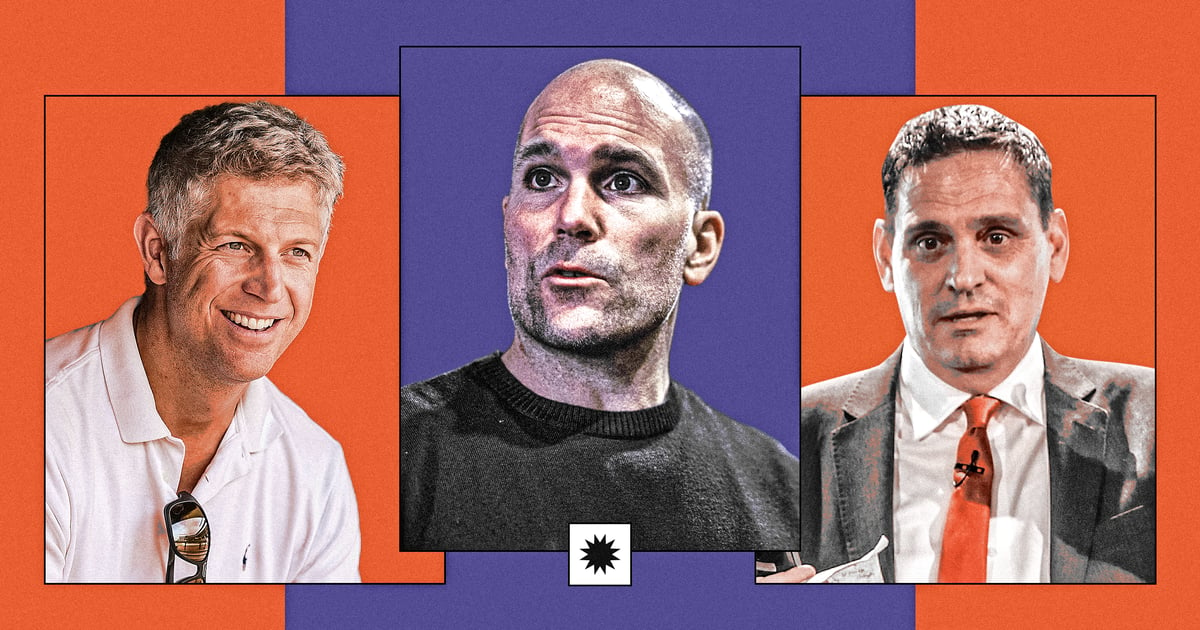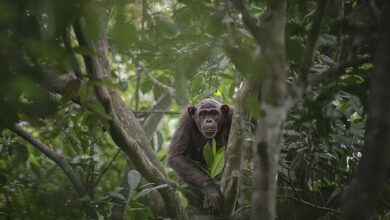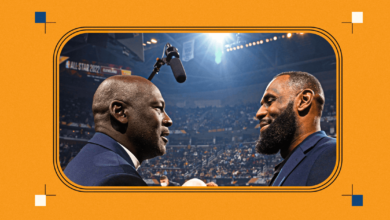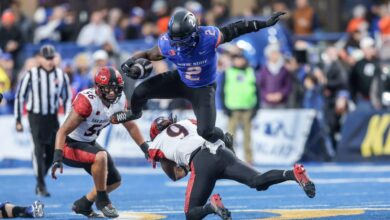Traditionally birds of a different feather, Orioles and Ravens building unique bond in Baltimore

Eric DeCosta was on vacation on Cape Cod, his last downtime for many months. Training camp was still a few weeks away, and the Baltimore Ravens had no pressing issues at the moment.
The mind of a talent evaluator, though, never rests. DeCosta’s childhood dreams of finding and developing players, drafting and building a roster went beyond becoming an NFL general manager. A devout Boston Red Sox fan, the Ravens GM once thought plenty about running a baseball team. All these years later, there are times when he still does.
Watching the Hyannis Harbor Hawks of the Cape Cod League, one of the top summer showcases for college baseball players, DeCosta observed the prospects on the field. He made mental notes of size, athleticism and field presence. He then got his phone out and started texting.
Top Orioles executives Mike Elias and Sig Mejdal don’t ask for DeCosta’s unstructured baseball scouting reports. Yet they look forward to them every summer. “I’ve told him when he’s on the Cape that I’m going to send him a radar gun and I expect some reports written,” said Elias, the Orioles executive vice president and GM. “He’s going to have to put his money where his mouth is and go on the record on some of these players.”
The downtown neighbors in a provincial Baltimore sporting landscape traditionally have kept each other at arm’s length. Beyond the occasional shared promotion, photo op or congratulatory social media post, the Ravens and Orioles maintained a distance that exceeded the half mile separating Oriole Park at Camden Yards and the Ravens’ M&T Bank Stadium. In recent months, that’s started to change.
New Orioles owner David Rubenstein reached out to Ravens owner Steve Bisciotti when his bid to purchase the Orioles from the Angelos family neared approval earlier this year. In April, Bisciotti and Rubenstein combined on a $10 million donation to support those most impacted by the collapse of Baltimore’s Key Bridge.
That collaboration at the ownership level represented a breakthrough; Bisciotti and former Orioles owner Peter Angelos weren’t adversarial, but they never got to know each other, either. The Ravens hosted a group of Orioles coaches and players at a training camp practice last month and again at their second preseason game. Ravens coach John Harbaugh recently took in Orioles batting practice as a guest of manager Brandon Hyde, the two having built a rapport over the past couple of years.
But nowhere is the growing bond between the two organizations more evident than in the friendship between the respective leaders of the team’s front offices. DeCosta built a relationship with Mejdal, the Orioles assistant general manager, well before Mejdal and Elias arrived in Baltimore in 2018 and were tasked with resuscitating an organization in need of a rebuild. DeCosta has cultivated a more recent friendship with Elias, too.
The executives have done speaking engagements together and spent time with one another in social settings. Their families have gotten to know each other. DeCosta’s daughter, Jane, babysits Elias’ kids. Mejdal’s wife, Arati, is a yoga instructor for the Ravens. Mejdal and his son even served as ball boys before a Ravens regular-season game, catching Justin Tucker field goals and making sure the football got back to the long snapper.
On the night of MLB’s 2022 draft, DeCosta was a guest of Elias and Mejdal in the Orioles draft room when they made Jackson Holliday the first pick. Twenty months later, the Orioles’ top executives were at the Ravens’ Under Armour Performance Center on a late April evening, when DeCosta chose Clemson cornerback Nate Wiggins in the first round of the 2024 NFL Draft. It’s a relationship that has benefited both teams.
“It was a celebration of Baltimore in a way,” DeCosta said. “We have two pretty damn good teams here. I want the fans to see that we have that relationship. I think fans want to celebrate what we both have going on. I really do value those guys. It’s a beautiful thing.”

The Ravens and Orioles have historically kept each other at arm’s length. (Kirby Lee / Getty Images)
Orioles GM Dan Duquette’s contract was not renewed after a 47-115 season in 2018, and the team was undergoing a front-office overhaul. DeCosta had never met Louis Angelos, the son of Peter Angelos, but they had mutual acquaintances — and the Ravens executive had someone in mind for the job.
Elias, then in the Houston Astros front office, was viewed as a prime GM candidate. And there was a sense around the league that Mejdal, the former NASA biomathematician who specialized in sabermetrics, might be willing to come with him.
DeCosta texted Louis Angelos and told him that he had some GM candidates he wanted to talk to him about. Angelos suggested the two meet at a Baltimore-area coffee shop. DeCosta was expecting the conversation to last about 30 minutes. Instead, the two spoke for more than two hours in a conversation that initially focused on Elias and Mejdal but expanded to touch on collaboration, team building, analytics and scouting.
“He’s a really thoughtful guy,” DeCosta said. “He was really hoping that we could have a relationship and there was going to be a relationship with the teams. We talked about Mike and Sig and my experiences with them and how I really thought these guys were brilliant and smart and how what they were able to do with the Astros was incredible.”
DeCosta learned quickly that Elias and Mejdal had been on the Orioles’ radar well before he sat down with Angelos. Still, DeCosta figured a few more supportive words couldn’t hurt. Then, he waited for the news like everyone else.
“Eric was probably our biggest supporter,” Mejdal said. “He was checking in with me what seemed to be every other day, more frequently than my own family.”
That didn’t stop when the job offers were extended, and accepted. “When we got the job, my wife and myself, we knew zero people in Baltimore other than Eric and his wife, Lacie, and (former Ravens analytics manager) Corey Krawiec,” Mejdal said. “They are just kind people. They invited us to dinner. They welcomed us and some of their friends became our friends. They’ve made our Baltimore life so much better.”
DeCosta is an ardent reader. He enjoys learning about successful people, organizations and companies. He remembers reading about how the St. Louis Cardinals became one of baseball’s model organizations in part because of a player development machine that relied heavily on statistical analysis. DeCosta believes that’s when he first learned about Mejdal, who joined the Cardinals analytics department in 2005 and stayed through 2011 before heading to Houston.
When Bisciotti encouraged DeCosta, the assistant GM at the time, to beef up the Ravens’ analytics program in 2011, the organization hired consultants to accelerate the process. DeCosta admits now that mistakes were made in how the program was initially structured, but one thing that served the Ravens well was networking. They met with numerous professional sports teams, including the Cleveland Indians (now Guardians), New York Yankees and Detroit Red Wings, to exchange ideas. They also made a point to reach out to the Astros.
“They were the gold standard in sports,” DeCosta said. “For us to build a relationship with them in terms of analytics was a big deal for us.”
Mejdal dropped by the Ravens’ facility in August 2016 while the Astros were in Baltimore and met with DeCosta and other members of the organization to provide insight into how Houston was using analytics as part of its draft preparation. Later that night, DeCosta was a guest of Mejdal and then-Astros GM Jeff Luhnow in a suite at Camden Yards.
DeCosta shifted uncomfortably in his seat as the Orioles became the first team since 1900 to hit four home runs before making their first out. Tightly wound, and knowing how agitated he gets during games when things aren’t going the Ravens’ way, DeCosta asked Luhnow and Mejdal if they wanted him to leave.
“I didn’t know them that well, but if it had been a football game, I know I can’t watch it with a bunch of randoms,” DeCosta said.
Luhnow and Mejdal reminded DeCosta that it was only one of 162 and there was still plenty of baseball to play. Sure enough, the Astros came back and won the game, 15-8, and the seeds of a friendship were planted. (Luhnow would later be fired and suspended from baseball after The Athletic reported that the Astros had used technology to illegally steal signs during their 2017 championship run. MLB’s eventual investigation did not implicate Elias or Mejdal.)
DeCosta found Mejdal to be an easy communicator and a fun guy to have a beer with. Contrary to the stereotypes associated with analysts and quants, Mejdal struck DeCosta as engaging and curious. He seemed to ask the right questions at the right time and didn’t take himself too seriously. “Unlike a lot of people in sports,” DeCosta said.
Mejdal, for his part, was impressed by DeCosta’s “growth mindset” and how eager he was to learn, from the time he first reached out to Mejdal.
“If you think you know it all, you don’t do that,” Mejdal said. “That reveals a modesty I admire very much.”
In 2018, Mejdal invited the DeCostas to an ALCS game between the Astros and Red Sox at Minute Maid Park. DeCosta stayed quiet as his beloved Red Sox prevailed — “I was joyful on the inside,” he said — but he was enthralled by how Mejdal clinically watched and analyzed the game, his mind working on every pitch.
“I’m watching the players and looking and evaluating their skills, and he’s looking at it from the standpoint of the science of baseball,” DeCosta said. “That was just really impressive to me.”

Elias and Mejdal were there when the Ravens selected Nate Wiggins (left) with this year’s first-round draft pick, while DeCosta sat in as the Orioles took Jackson Holliday (right) in 2022. (Scott Taetsch / Getty Images; Nick Cammett / Diamond Images via Getty Images)
A general manager lives what Mejdal calls “an imbalanced lifestyle.” So much time spent away from home and loved ones, family dinners and vacations interrupted by phone calls and text messages. There’s a lot on the line, and so many people are impacted by each decision a GM makes.
“Our jobs are really hard,” Elias said. “You have a lot that you’re having to balance, and every decision you make can weigh on you. There’s just very few people that have lived through that and have practical experience in that chair and understand the difficulties that you can seek advice from and know that they don’t have any particular agenda. It’s really nice to have Eric for me as a resource.”
Before a recent draft, Elias encountered a situation that was unusual for a baseball GM but that football GMs deal with more regularly (neither side was willing to provide the details). Seeking counsel, he called DeCosta. The roles have been reversed, too.
The two have similar backgrounds, both “scouts at heart” who have grown up in forward-thinking organizations determined to involve analytical input in the player evaluation process. When DeCosta was a guest in the Orioles’ draft room in 2022, an experience that he called one of the most enjoyable of his professional career, he took notes and paid particular attention to how the Orioles decision-makers processed so much information and weighed subjective scout observations with data-driven analysis. DeCosta was also in Elias’ office as he negotiated Holliday’s signing bonus with agent Scott Boras.
When the favor was returned, Elias marveled at the large digital boards in the Ravens’ draft room and the calmness, even when Baltimore was almost on the clock and phones rang incessantly with offers to trade back.
“Even though we’re in different sports, the nature of the draft is similar,” Mejdal said. “You have this finite, often large amount of information about each player, all of these different attributes, and they don’t all point in the same direction. As you get more and more sophisticated with the draft decisions, it becomes more an exercise in combining information. To see how another sport does it, especially with a team that’s on the forefront of it, is a tremendous opportunity.”

Everyone from the GMs to the mascots seems to be feeling the connection in Baltimore these days. (G Fiume / Getty Images)
The players have gotten in the act as well. As the Ravens were working through special teams drills at the start of a recent practice, their 23-year-old safety Kyle Hamilton, already an All-Pro, stood on the sideline engaged in a conversation with 23-year-old Orioles shortstop Gunnar Henderson, an All-Star, former Rookie of the Year and a current MVP candidate.
They posed for a picture, two faces of the franchises wearing wide grins. It was a treat for the city’s bird-loving sports fans, who have long celebrated glimpses of synergy — however small — between Baltimore’s two most prominent professional sports teams.
“It’s fun for us. They are the best at what they do and we’re hoping to be the same,” Elias said. “These sports teams have a relative importance to the city that is way beyond the average for a sports franchise. The health of the city, economically, and the national stature of the city are driven quite a bit by what these franchises do, how they are run, how they plan.
“We should be working together on that front. I know that the baseball and football operations have very close relationships now, but it’s exciting to see at the ownership and business operations level, that’s only going to grow.”
For a good number of years, late summer in Baltimore meant that the city’s sports fans had turned the page on a disappointing Orioles season and were already locked into the Ravens. That, however, has changed.
The Orioles are one of the top teams in baseball for a second consecutive year, thanks to a roster loaded with young stars such as Henderson, Holliday and catcher Adley Rutschman. It’s not hard to envision them playing deep into October for years to come, while the Ravens hit their stride during their regular season.
“I didn’t really know much about the Baltimore sports culture,” Mejdal said. “I had no idea how important baseball and football are to the people of Baltimore. I had no idea of the reverence they have for the players, the game, Camden Yards. That has made it a pleasure to be involved in this. I’ve seen Ravens playoff games and that energy is clear in football, too.
“Why in the world wouldn’t these two organizations that are so important to the city work together? It just seems inevitable and natural.”
(Top image: Meech Robinson / The Athletic; Photos: Nick Cammett / Diamond Images via Getty Images; Lloyd Fox / Baltimore Sun / Tribune News Service via Getty Images; Claire Greenway / Getty Images; G Fiume / Getty Images)




